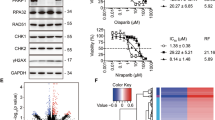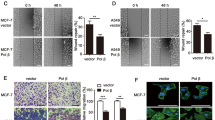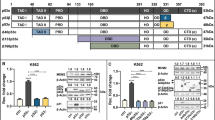Abstract
The low-fidelity DNA polymerases thought to be specialized in DNA damage processing are frequently misregulated in cancers. We show here that DNA polymerase kappa (polκ), prone to replicate across oxidative and aromatic adducts and known to function in nucleotide excision repair (NER), is downregulated in colorectal tumour biopsies. Contrary to the replicative polδ and polα, for which only activating domains were described, we identified an upstream 465-bp-long repressor region in the promoter of POLK. We also found an activating 237-bp region that includes stimulating protein-1 (SP1) and cyclic AMP-responsive element (CRE)-binding sites. Mutations at one CRE-binding site led to a dramatic 80% decrease in promoter activity. Alterations of the SP1-binding site also affected, to a lesser extent, the transcription. Gel shift assays confirmed the role played by CRE/SP1 recognition sequences. Moreover, ectopic expression of SP1 or CRE-binding protein (CREB) protein favoured polκ transcription. Finally, we found that polκ downexpression in colorectal biopsies correlated with a decreased level of CREB and SP1 transcripts. This work shows that the promoter of POLK is cis-controlled and suggests that silencing of CREB and SP1 proteins could contribute to downregulation of this repair polymerase in colorectal tumours.
This is a preview of subscription content, access via your institution
Access options
Subscribe to this journal
Receive 50 print issues and online access
$259.00 per year
only $5.18 per issue
Buy this article
- Purchase on Springer Link
- Instant access to full article PDF
Prices may be subject to local taxes which are calculated during checkout







Similar content being viewed by others
References
Albertella MR, Lau A, O'Connor MJ . (2005). The overexpression of specialized DNA polymerases in cancer. DNA repair 4: 583–593.
Anacleto C, Leopoldino AM, Rossi B, Soares FA, Lopes A, Rocha JC et al. (2005). Colorectal cancer ‘methylator phenotype’: fact or artifact ? Neoplasia 7: 331–335.
Arita M, Zhong X, Min Z, Hemmi H, Shimatake H . (2003). Multiple sites required for expression in 5′-flanking region of the hMLH1 gene. Gene 306: 57–65.
Atlas E, Stramwasser M, Mueller CR . (2001). A CREB site in the BRCA1 proximal promoter acts as a constitutive transcriptional element. Oncogene 20: 7110–7114.
Bannister AJ, Miska EA . (2000). Regulation of gene expression by transcription factor acetylation. Cell Mol Life Sci 57: 1184–1192.
Bartkova J, Horejsi Z, Koed K, Kramer A, Tort F, Zieger K et al. (2005). DNA damage response as a candidate anti-cancer barrier in early human tumorigenesis. Nature 434: 864–870.
Bavoux C, Hoffmann JS, Cazaux C . (2005a). Adaptation of DNA damage and stimulation of genetic instability: the double-edged sword mammalian DNA polymerase kappa. Biochimie 87: 637–646.
Bavoux C, Leopoldino AM, Bergoglio V, O-Wang J, Ogi T, Bieth A et al. (2005b). Upregulation of the error-prone DNA polymerase kappa promotes pleiotropic genetic alterations and tumorigenesis. Cancer Res 65: 325–330.
Bergoglio V, Bavoux C, Verbiest V, Hoffmann JS, Cazaux C . (2002). Localisation of human DNA polymerase kappa to replicative foci. J Cell Sci 115: 4413–4418.
Bergoglio V, Ferrari E, Hubscher U, Cazaux C, Hoffmann JS . (2003). DNA polymerase beta can incorporate ribonucleotides during DNA synthesis of undamaged and CPD-damaged DNA. J Mol Biol 29: 1017–1023.
Briggs MR, Kadonaga JT, Bell SP, Tjian R . (1986). Purification and biochemical characterization of the promoter-specific transcription factor, Sp1. Science 234: 47–52.
Capp JP, Boudsocq F, Bertrand P, Laroche-Clary A, Pourquier P, Lopez B et al. (2006). The DNA polymerase lambda is required for the repair of non-compatible DNA double strand breaks by NHEJ in mammalian cells. Nucleic Acids Res 34: 2998–3007.
Chen LF, Greene WC . (2003). Regulation of distinct biological activities of the NF-kappaB transcription factor complex by acetylation. J Mol Med 81: 549–557.
Duriseti S, Winnard P, Mironchik Y, Vesuna F, Raman A, Raman V . (2006). HOXA5 regulates hMLH1 expression in breast cancer cells. Neoplasia 8: 250–258.
Feng Y, Goulet AC, Nelson MA . (2004). Identification and characterization of the human Cdc2l2 gene promoter. Gene 330: 75–84.
Gorgoulis VG, Vassiliou L, Karakaidos P, Zacharatos P, Kotsinas A, Liloglou T et al. (2005). Activation of the DNA damage checkpoint and genomic instability in human precancerous lesions. Nature 434: 907–913.
Herman JG, Graff JR, Myohanen S, Nelkin BD, Baylin SB . (1996). Methylation-specific PCR: a novel PCR assay for methylation status of CpG islands. Proc Natl Acad Sci USA 93: 9821–9826.
Hernan JG, Umar A, Polyak K, Graff JR, Ahuja N, Issa JP et al. (1998). Incidence and functional consequences of hMLH1 promoter hypermethylation in colorectal carcinoma. Proc Natl Acad Sci USA 95: 6870–6875.
Hubscher U, Maga G, Spadari S . (2002). Eukaryotic DNA polymerases. Annu Rev Biochem 71: 133–163.
Iwanaga R, Komori H, Ohtani K . (2004). Differential regulation of expression of the mammalian DNA repair genes by growth stimulation. Oncogene 23: 8581–8590.
Kedar P, Widen S, Englander E, Fornace A, Wilson S . (1991). The ATF/CREB transcription factor-binding site in the polymerase beta promoter mediates the positive effect of N-methyl-N′-nitro-N-nitrosoguanidine on transcription. Proc Natl Acad Sci USA 88: 3729–3733.
Lehmann A . (2003). Low-fidelity DNA polymerases. Curr Biol 5: 13.
McIlwraith M, Vaisman A, Liu Y, Fanning E, Woodgate R, West S . (2005). Human DNA polymerase eta promotes DNA synthesis from strand invasion intermediates of homologous recombination. Mol Cell 20: 783–792.
Nick McElhinny SA, Havener JM, Garcia-Diaz M, Juarez R, Bebenek K, Kee BL et al. (2005). A gradient of template dependence defines distinct biological roles for family X polymerases in non homologous end joining. Mol Cell 19: 357–366.
Ogi T, Kannouche P, Lehmann AR . (2005). Localisation of human Y-family DNA polymerase kappa: relationship to PCNA foci. J Cell Sci 118: 129–136.
Ogi T, Lehman AR . (2006). The Y-family DNA polymerase kappa functions in mammalian nucleotide-excision repair. Nat Cell Biol 8: 640–642.
Ray R, Snyder R, Thomas S, Koller C, Miller D . (1989). Mithramycin blocks protein binding and function of the SV40 early promoter. J Clin Invest 83: 2003–2007.
Servant L, Bieth A, Cazaux C, Hoffmann JS . (2002). Involvement of DNA polymerase beta in DNA replication and mutagenic consequences. J Mol Biol 315: 1039–1047.
Shin T, Sumiyoshi H, Matsuo N, Satoh F, Nomura Y, Mimata H et al. (2005). Sp1 and Sp3 transcription factors upregulate the proximal promoter of the human prostate-specific antigen gene in prostate cancer cells. Arch Biochem Biophys 435: 291–302.
Singhal R, Prasad R, Wilson S . (2006). DNA polymerase beta conducts the gap-filling step in uracil-initiated base excision repair in a bovine testis nuclear extract. J Biol Chem 270: 949–957.
Velasco-Miguel S, Richardson JA, Gerlach VL, Lai WC, Gao T, Russell LD et al. (2002). Constitutive and regulated expression of the mouse Dinb (Polkappa) gene encoding DNA polymerase kappa. DNA Repair 2: 91–106.
Acknowledgements
We thank K Gordien (Canceropole GSO) for annotation of tumours. This work was supported by the Ligue Nationale Contre le Cancer (labellization to JSH), Canceropole GSO (ACI 2004–2007 to CC) and CAPES-COFECUB (351/01). FL and CB were supported by the Institut National du Cancer (INCa) and LNCC/Association pour la Recherche sur le Cancer (ARC) fellowships, respectively.
Author information
Authors and Affiliations
Corresponding author
Additional information
Supplementary Information accompanies the paper on the Oncogene website (http://www.nature.com/onc).
Supplementary information
Rights and permissions
About this article
Cite this article
Lemée, F., Bavoux, C., Pillaire, M. et al. Characterization of promoter regulatory elements involved in downexpression of the DNA polymerase κ in colorectal cancer. Oncogene 26, 3387–3394 (2007). https://doi.org/10.1038/sj.onc.1210116
Received:
Revised:
Accepted:
Published:
Issue Date:
DOI: https://doi.org/10.1038/sj.onc.1210116
Keywords
This article is cited by
-
A ‘DNA replication’ signature of progression and negative outcome in colorectal cancer
Oncogene (2010)
-
Y-family DNA polymerases in mammalian cells
Cellular and Molecular Life Sciences (2009)
-
Novel evidences for a tumor suppressor role of Rev3, the catalytic subunit of Pol ζ
Oncogene (2008)



